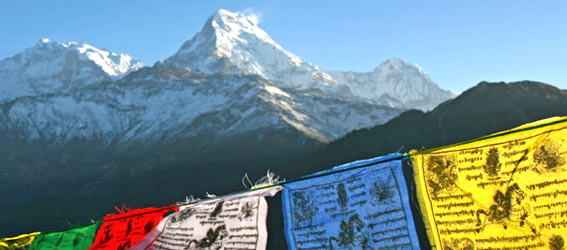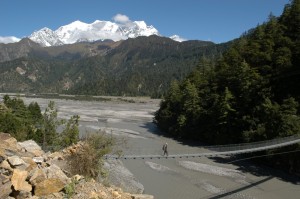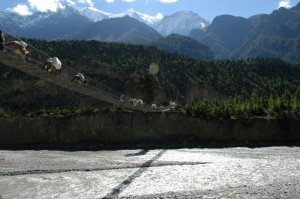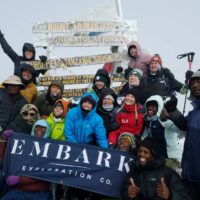What are the Best Areas for Trekking in Nepal?
11.29.2016

If most hikers were to rank the world’s destinations, it’s hard to think that any place other than Nepal would be at the top.

If you want jungles, remote villages, ancient religious sites, traditional people, forests, a huge network of paths, and of course the biggest mountains in the world, Nepal is where you want to go.
But where in Nepal? With all the options available, what are the classic areas where a hiker, trekker or even climber can experience the true essence of this amazing country?
We have chosen three places to highlight — Annapurna, Khumbu, and Langtang — and offer you a brief introduction to each.
Annapurna Conservation Area
 At nearly 3,000 square miles, this is Nepal’s largest protected area. But even that doesn’t begin to describe it. Consider: Within Annapurna you will find several of the world’s tallest mountains and the world’s deepest gorge.
At nearly 3,000 square miles, this is Nepal’s largest protected area. But even that doesn’t begin to describe it. Consider: Within Annapurna you will find several of the world’s tallest mountains and the world’s deepest gorge.
In this range, from 2,590 feet to 26,545 feet above sea level, one finds an incredible diversity of ecosystems and conditions. For example, the southern (lower) end gets 120 inches of annual rain; at the high northern end, 75 miles away, gets 20 inches. Along the way you would pass through habitats from subtropical forest through 22 other forest types and eventually into the world of rock, ice, and perpetual snow. There are also more than 1,200 plant species, 30 mammals (Including the snow leopard and Tibetan fox) and 450 birds. Even the humans are diverse; Annapurna’s 100,000 residents fall into 10 ethnic groups.
Annapurna is the most popular trekking area in Nepal, with some 40,000 annual visitors coming during the peak times of spring and autumn. Of the many options, almost all starting from the town of Pokhara, we most love the Annapurna Base Camp trek and the Annapurna Circuit.
Annapurna Base Camp
 This 12-day excursion is one of the best treks in all of Nepal, in part because it is the least disturbed by road construction and other forms of modernization. It’s usually a 14-day trip out of Pokhara, with stupendous views throughout. The most famous is at sunrise from Poon Hill, at just over 9,000 feet. Here you will see all of the Annapurna Range as well as the massive Dualaghiri, the world’s seventh highest peak.
This 12-day excursion is one of the best treks in all of Nepal, in part because it is the least disturbed by road construction and other forms of modernization. It’s usually a 14-day trip out of Pokhara, with stupendous views throughout. The most famous is at sunrise from Poon Hill, at just over 9,000 feet. Here you will see all of the Annapurna Range as well as the massive Dualaghiri, the world’s seventh highest peak.
Continuing on towards base camp, after 5 to 7 Days you pass through a narrow gorge and into the magical Annapurna Sanctuary, where the greatest peaks of the Annapurna (several of them above 21,000 feet) surround align in a 10-mile circle bone a plateau at 12,000 feet elevation. It was not even penetrated by outsiders until 1956! If you believe in mountain gods, then this must surely be their throne room.
Annapurna Circuit
 On this walk, typically of about 15 days, you will experience the full range of Annapurna’s diversity. Commencing in the a river gorge filled with countless streams, we eventually emerge into high desert country at Manang (3597 m.). A long, steady climb (good for acclimatization) brings you to the world-famous pass of Thorang-La (5416 m.). From there, we descend to Muktinath in the lower Mustang region (neighboring Tibet), one of the holiest pilgrimage sites for Buddhist and Hindu people in Nepal.
On this walk, typically of about 15 days, you will experience the full range of Annapurna’s diversity. Commencing in the a river gorge filled with countless streams, we eventually emerge into high desert country at Manang (3597 m.). A long, steady climb (good for acclimatization) brings you to the world-famous pass of Thorang-La (5416 m.). From there, we descend to Muktinath in the lower Mustang region (neighboring Tibet), one of the holiest pilgrimage sites for Buddhist and Hindu people in Nepal.
Heading out now, we pass through arid lands to the historical fortress town of Kagbeni, then follow the Kali Gandaki River, through the world’s deepes gorge, to Jomsom. We can fly out from here or walk back out the way of that view at Poon Hilll, saying goodbye for now to a massive range of peaks we have now walked around.
Khumbu and Everest Base Camp
 Certainly the most famous trek in Nepal, and probably the world, a trip to Everest Base Camp is the ultimate “bucket list” for lovers of a mountain walk. But the destination here is not even what the whole area is about.
Certainly the most famous trek in Nepal, and probably the world, a trip to Everest Base Camp is the ultimate “bucket list” for lovers of a mountain walk. But the destination here is not even what the whole area is about.
Again, there is a tremendous variety of habitats, from Forests of silver fir, birch and rhododendron with spectacular blooms in spring. At the top, of course, is the literal roof of the world at SOMETHING feet, and in between you might spot Himalayan black bears and red pandas.
The Sherpa people call this area home, and their lives are richly connected to renowned Buddhist monasteries such as Tengboche and others.
All of this, of course, adds up to the most popular trekking area in Nepal. However, there are many routes to the same place, each with its own charms, and we are most fond of the one from Namche to Tengboche.
Trekking to Everest Base Camp
 Most of this trek’s 40,000 annual visitors start by flying from Kathmandu to the airstrip at Lukla, which gets you very quickly to nearly 10,000 feet elevation. From here, it’s two days of steady climbing to Namche Bazaar, the Sherpa capital, for a day of rest and acclimatization. Two more days gets you a visit to the famous monastery at Tyengboche, and after another day of rest an additional two days on trail lands you at Gorakshep, an ancient lake bed just under 17,000 feet elevation and within Sagarmatha National Park.
Most of this trek’s 40,000 annual visitors start by flying from Kathmandu to the airstrip at Lukla, which gets you very quickly to nearly 10,000 feet elevation. From here, it’s two days of steady climbing to Namche Bazaar, the Sherpa capital, for a day of rest and acclimatization. Two more days gets you a visit to the famous monastery at Tyengboche, and after another day of rest an additional two days on trail lands you at Gorakshep, an ancient lake bed just under 17,000 feet elevation and within Sagarmatha National Park.
From here, Everest looms over all — though, ironically, it can’t actually be seen from the climbers’ base camp. Instead, the next morning you will rise early and climb Kala Patthar, which at just over 18,000 feet is the highest one can go without a climbing permit and offers the best view of Everest you can imagine. Being here at sunrise will give you an image that will linger in your mind as you walk back down what the Dalai Lama has called “the stairs to heaven.”
Langtang
What sets Langtang apart from these other areas is that it isn’t among the high peaks of the Himalayas, though it certainly offers views of them. Instead, it is a region with fascinating cultural and religious sites, as well as Langtang National Park, Npeal’s fourth largest. This park also links with a nature reserve in Tibet, which borders Langtang, meaning the area is rich in many ways — but not visited by nearly as many people as Khumbu or Annapurna.
Langtang to Gosaikunda Lakes
The destination here is a set of alpine lakes around 14,000 feet in elevation, which are considered sacred by Hindus all over the world. It is said to have been created by Lord Shiva, when he thrust his sword into the mountain for a drink of water. Every August, thousands of Hindus from Nepal and India make pilgrimage here for ancient festivals.
The trek to Gosaikunda follows the Langtang Valley through forests filled with pandas and monkeys and bears. There are spectacular mountain views, but what makes trekking here unique is that not many people do it. This adds a certain romance and adventure to the experience, and speaking of romance, Langtang is one of the leading areas for sightings of the mythical yeti. Truly it’s a place to experience the real, traditional Nepal and be surprised all the time.



